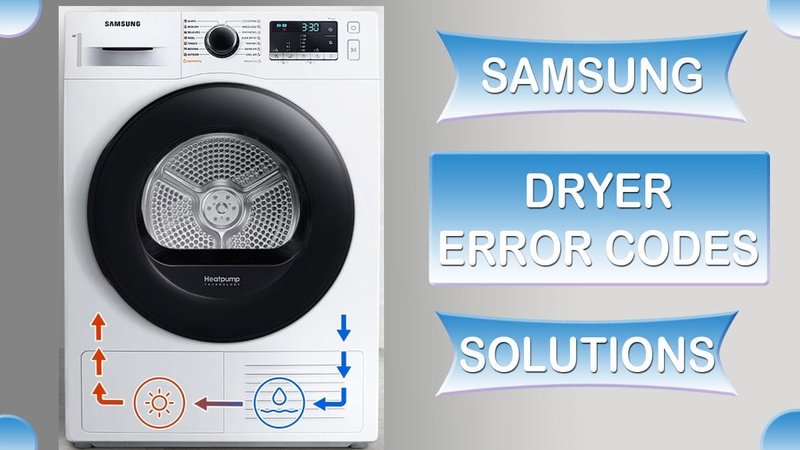
Let’s paint a picture: think of the F1 error code as your dryer’s way of waving a red flag. It’s a signal that something isn’t quite right. But what exactly does it represent? Typically, the F1 code on a Samsung dryer indicates a communication fault between the dryer’s control board and one of its components. It’s like when your computer has trouble syncing up with the printer—it can’t do its job properly without clear communication. So, is it safe to overlook this and continue using your dryer? Not quite. Let’s dive deeper and see why.
What Does Error Code F1 Mean?
When you see the F1 error code flash on your dryer, it might feel a little daunting. But let’s break it down: the F1 code is essentially the dryer’s way of saying, “Hey, I need some attention here!” It often points to an issue with the dryer’s internal communication system. Just like a car needs all its parts to work in harmony to run smoothly, your dryer relies on its components to interact correctly.
In the world of appliances, the control board is like the brain of the operation. It tells the dryer what to do and when to do it. The F1 code generally signals that there’s a hiccup in this brainpower. Maybe the control board isn’t getting the right information from a sensor, or perhaps a wire is loose or damaged. When this happens, the dryer might not operate as it should, leading to potential inefficiencies or even damage over time.
So, what does this mean for you, the user? If your dryer is displaying the F1 code, it’s essential to act rather than ignore it. Just as you wouldn’t drive a car with the check engine light on for too long, it’s crucial to address this issue promptly. Doing so can prevent further problems and ensure your dryer keeps running smoothly for years to come.
Should You Continue Using the Dryer?
Here’s the deal: using a Samsung dryer with an F1 error code is a bit like walking a tightrope. You might get across, or you might not. While the dryer might still function at a basic level, ignoring the error can lead to bigger problems down the line. It’s like having a small leak in your roof—you might not notice the damage day to day, but eventually, it could lead to a ceiling collapse.
Continuing to use your dryer without addressing the F1 code can increase wear and tear on the appliance. The error could be a symptom of a larger issue that, left unchecked, might result in more costly repairs. It’s also important to think about safety; a malfunctioning dryer could potentially pose a risk as it involves both heat and electrical components.
If you’re weighing your options, the best course of action is to consult your dryer’s manual or contact customer support for Samsung. They’ll provide guidance specific to your model and might suggest a simple fix or recommend a technician to check things out. Remember, addressing the error promptly can save you time, money, and stress in the long run.
Steps to Take When You See F1
So, you’ve got an F1 error code, what’s next? First thing’s first: don’t panic. Here’s a step-by-step approach to tackling this head-on. Start by performing a quick reset of your dryer. Unplug it from the power source, wait a few minutes, and plug it back in. This can sometimes clear minor glitches, just like rebooting a slow computer.
Next, check your manual. This handy booklet is packed with model-specific troubleshooting tips and could provide the clarity you need. If resetting doesn’t work and the manual doesn’t help, it might be time to explore deeper. Inspect the dryer’s wiring and control board, if you’re comfortable doing so. Look for any visible signs of damage or disconnection.
For most folks, though, reaching out to a professional is the safest bet. A certified technician can accurately diagnose and fix the problem. They’ve got the tools and expertise to do what’s needed without issue. And here’s a pro tip: regular maintenance checks can preemptively address potential problems before they become real headaches.
Preventing Future Error Codes
The best way to deal with error codes is to prevent them from showing up in the first place. How do you do that? Think of it like taking care of your car with regular oil changes and tune-ups. The same principle applies here: routine maintenance can keep your dryer happy and healthy.
Start by ensuring your dryer is installed correctly and that it’s level. This can help prevent unnecessary strain on internal components. Regularly clean the lint filter and make sure the ventilation is clear. This not only enhances efficiency but also reduces fire risk—an important safety step for any dryer owner.
It’s also wise to occasionally inspect and clean the dryer’s interior, especially the drum and any visible sensors. Checking the condition of the power cord and plug, as well as the outlet, helps ensure that electricity flows smoothly where it’s supposed to. By staying attentive to these details, you can reduce the chance of encountering the dreaded F1 error code and prolong the life of your dryer.
Remember, your dryer is an investment. Just like any other tool or appliance, it needs a bit of care and attention to function at its best. By following these preventive measures, you can keep your laundry routine smooth and your dryer running safely and efficiently.